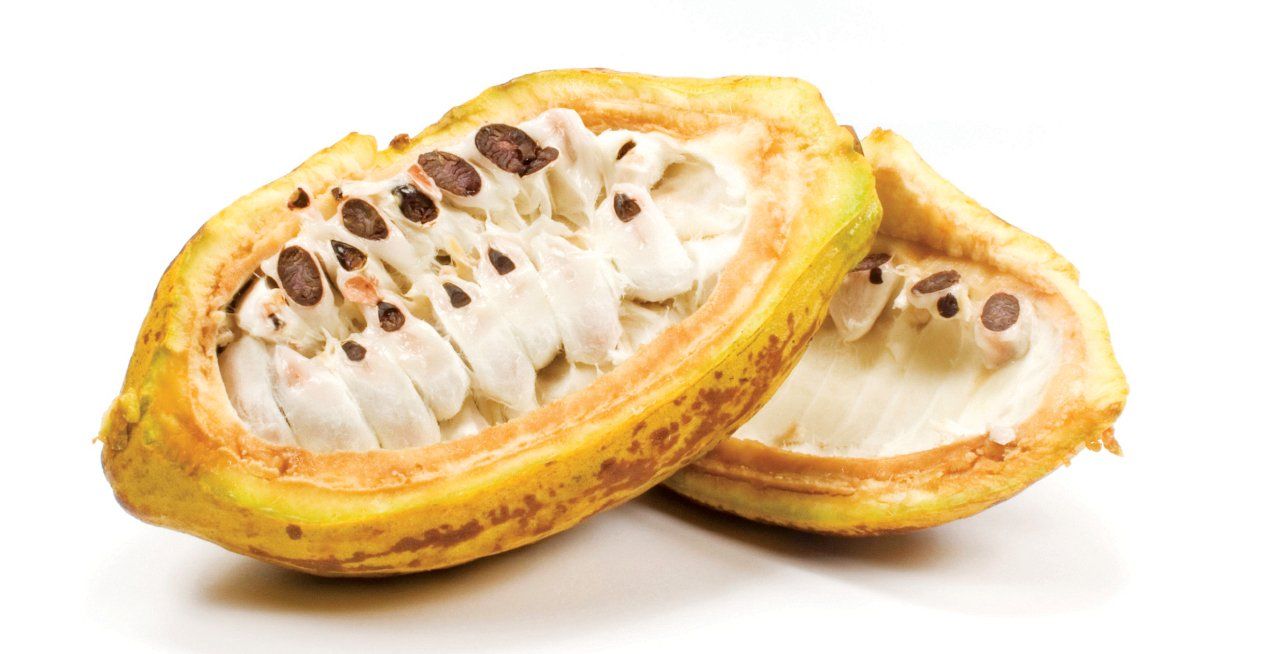Cacao Pulp: It's Not Just a Waste Product of Cocoa Anymore
The nutritional benefits and functional potential of this fleshy pulp are worth another look.

Inside of every cacao fruit (Theobroma cacao) lies a cluster of cacao beans, the starting material for finished cocoa and chocolate products. To get to these beans, however, requires the removal of a thin layer of white pulp. If it isn’t left on the beans during fermentation, the pulp is simply thrown out.
Despite the intensive labor required to peel off this fleshy pulp, a few cocoa suppliers are, somewhat simultaneously, finding valuable commercial uses for what many would otherwise call a waste product of cocoa. Their discoveries could change the market for cacao (the fruit) and cocoa (the processed product) as we know it.
Beverages
A quick look at the historical use of cacao pulp reveals that cacao farmers, and their immediate communities, have long enjoyed the pulp as juice. Inspired by this tradition and seeing it at his family’s own cacao farms in Ecuador, Joseph Montgomery is heading up Agro Innova Co. (Weston, FL) with the 2013 launch of Suavva, the first commercial-scale juice smoothie from cacao pulp.
Montgomery says that “like most fruits, the pulp is where the sweetness (fruit sugar) is found in cacao.” But sweetness alone might not warrant a business focused solely on pulp. Luckily, cacao pulp can fall back on many healthful nutrients.
A single serving of Suavva contains 270% of the daily reference intake (DRI) for vitamin E, 395% for vitamin D, 81% for magnesium, and high amounts of B vitamins. Other pulp ingredients are presumably as nutritious, but nutrient declarations are hard to come by at this early stage in the industry. If cacao juice really picks up, its combination of exotic origin, taste, and nutrition has all the makings of the “next” coconut water.
Powders and Extracts
The upstart cacao pulp market is capable of highly scientific and functional ingredients, too. Iris Naturals International (Forest Hills, NY) takes this approach by supplying Brazilian cacao pulp in powders and extracts.
Standardized cacao pulp ingredients are a strong candidate for formulas in which ingredients such as flavonoids (especially epicatechin) and methylxanthines (theobromine and caffeine) are desired. Famous for their presence in cacao beans, these compounds are naturally retained in the pulp, too, although to a lesser extent.
Iris Naturals says its soluble cacao pulp powder is suitable for yogurts, ice creams, beverages, and dry mixes. The insoluble pulp extract is better suited for bars, baked goods, cereals, confectionery, and cosmetics.
Fruit Fermentations
The old-school approach to cacao pulp is to simply use this material to ferment or “sweat” cacao beans. When left on beans for several days, in sun or artificial heat, pulp imparts its sweet and slightly acidic flavor and aroma to the beans. These beans aren’t often sold to U.S. markets-the national palette just isn’t accustomed to them, according to one supplier-so European markets enjoy much of the purchasing power. A new style of fermentation, however, could have everyone giving fermented cacao beans a second look.
Cocoa Family (Duarte, CA) is pleased to report that it is now fermenting its cacao beans with fruits and spices. Sample tests have yielded “delicious” results.
“During fermentation, we aerate the beans (move them) once or twice a day,” says Vaagn Arakelyan, Cocoa Family director of cocoa trade. “But now you have fruits chopped up and mixed in with the beans.” For now, the company is exploring chili, coconut, banana, orange, and mango as starter flavors.
Arakelyan says a “hint” of flavor is retained after the beans are dried, and even after light roasting. Although his company plans to market the fruit-infused beans heavily toward the raw cacao market, where the beans are eaten in their natural state, one can imagine the possibilities with chocolate made from fruit-infused beans. The project could offer a new level of control to chocolatiers, Arakelyan says, because “It’s one thing if you buy couverture and you’re limited to how you can use it. Now, you get a raw or lightly roasted bean with a natural hint of flavor, and you have more room for creativity.”
Cocoa Family says the idea of fruit-infused beans may carry over to similarly structured plant pods, such as coffee beans, mesquite, and Sacha Inchi seeds. We’ll just have to wait and see.





